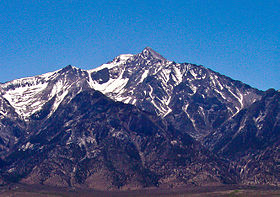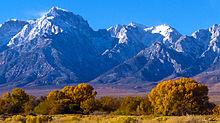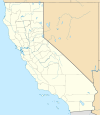- Mount Williamson
-
Mount Williamson 
Mount Williamson as seen from Manzanar in the Owens ValleyElevation 14,389 ft (4,386 m) [1][2] Prominence 1,643 ft (501 m) [2] Parent peak Mount Whitney[2] Listing SPS Emblem peak[3] Location Location in California Location Inyo County, California, USA Range Sierra Nevada Coordinates 36°39′22″N 118°18′40″W / 36.65611°N 118.31111°WCoordinates: 36°39′22″N 118°18′40″W / 36.65611°N 118.31111°W[4] Topo map USGS Mount Williamson Climbing First ascent 1884 by William L. Hunter and C. Mulholland[5] Easiest route Southeast face from George Creek, easy scramble, class 2[5] Mount Williamson, at 14,389 feet (4,386 m), is the second highest mountain in both the Sierra Nevada range and the state of California. It is the sixth highest peak in the contiguous United States.
Contents
Geography
Williamson stands in the John Muir Wilderness of the Inyo National Forest. It is located approximately 6 miles (9.7 km) north of Mount Whitney, the highest peak in the contiguous U.S., and about 2.5 miles (4.0 km) southeast of Shepherd Pass, the nearest trail access. The closest town is Independence, California, about 12 miles (19 km) north-north-east of the peak in the Owens Valley. It lies about 1 mile (1.6 km) east of the Sierra Crest, which forms the western edge of the Owens Valley. It is more remote than Whitney in terms of access; however, as it sits east of the crest, it is actually a bit closer to the Owens Valley floor than Whitney. For example, the drop from the summit to the forest edge is 8,000 feet (2,400 m) in approximately 4 miles (6.4 km). This makes it an imposing mountain, and far less of a popular climb than its higher neighbor.
History
The mountain is named for Lt. Robert Stockton Williamson (1825–1882), who conducted one of the Pacific Railroad Surveys in Southern California.[6]
The first recorded ascent of Mount Williamson was made in 1884 by W. L. Hunter and C. Mulholland, by way of the Southeast Slopes Route. The first ascent of the West Side Route was made in 1896 by Bolton C. Brown and Lucy Brown. New routes continued to be put up on the harder faces at least through the 1980s.[5]
Climbing
 Mount Williamson (left) (14,389 feet / 4,386 metres), from near the Independence Airport.
Mount Williamson (left) (14,389 feet / 4,386 metres), from near the Independence Airport.
The standard ascent route is the West Side Route, accessed from Shepherd's Pass. From the pass, one travels across the Williamson Bowl, which lies between Mount Williamson and Mount Tyndall, part of the Sierra Crest. The bowl is home to five high alpine lakes. From the bowl, the route climbs gullies up the west face to the relatively broad summit plateau; this portion involves scrambling up to class 3. Technically easier, but with a more difficult approach which can involve route finding and bushwhacking, is the Southeast Slopes Route, rising from George Creek. Other routes exist on the mountain, including a significant technical route on the North Rib (Grade IV, 5.7).[5]
Climbing Mount Williamson is made more difficult by the lengthy and strenuous approach. Elevation gain from the trailhead is over 8,000 feet (2,400 m), and the trail to Shepherd's Pass alone is 11 miles (18 km).
Mount Williamson is in the California Bighorn Sheep Zoological Area and these rare animals can often be seen on the lower slopes during the winter when heavy snows drive the sheep down from their summer grazing areas. From 1981 until 2010 the California Bighorn Sheep Zoological Area was closed to access for much of the year, but late in 2010, the Inyo National Forest Service declined to renew the closure, opening the area to access year-round.[7]
See also
- California 4000 meter peaks
- List of California fourteeners
- Mountain peaks of California
- Mountain peaks of North America
- Mountain peaks of the United States
References
- ^ The NGVD 29 elevation of 14,383 feet was converted using VERTCON to the NAVD 88 elevation of 14,389 feet.
- ^ a b c "Mount Williamson, California". Peakbagger.com. http://www.peakbagger.com/peak.aspx?pid=2814. Retrieved 2009-08-07.
- ^ "Sierra Peaks Section List". Angeles Chapter, Sierra Club. http://angeles.sierraclub.org/sps/spslist.pdf. Retrieved 2009-08-07.
- ^ "Mount Williamson". Geographic Names Information System, U.S. Geological Survey. http://geonames.usgs.gov/pls/gnispublic/f?p=gnispq:3:::NO::P3_FID:1654980. Retrieved 2009-08-07.
- ^ a b c d Secor, R.J. (1999). The High Sierra: Peaks, Passes and Trails (2nd ed.). Seattle: The Mountaineers Books. pp. 81–85. ISBN 0-89886-625-1.
- ^ Farquhar, Francis P. (1926). Place Names of the High Sierra. San Francisco: Sierra Club. http://www.yosemite.ca.us/library/place_names_of_the_high_sierra/w.html. Retrieved 2009-08-03.
- ^ "Forest Service Proposes to Change Designation of Bighorn Sheep Zoological Areas". United States Forest Service, Bishop, CA. September 25, 2010. http://www.fs.usda.gov/wps/portal/fsinternet/!ut/p/c4/04_SB8K8xLLM9MSSzPy8xBz9CP0os3gjAwhwtDDw9_AI8zPyhQoY6BdkOyoCAGixyPg!/?ss=110504&navtype=BROWSEBYSUBJECT&cid=STELPRDB5201581&navid=180000000000000&pnavid=null&position=News&ttype=detail&pname=Inyo%20National%20Forest-%20News%20&%20Events. Retrieved 2011-06-03.
External links
- "Mount Williamson". SummitPost.org. http://www.summitpost.org/page/150438. Retrieved 2011-06-03.
- "Ansel Adams: Classic Images". Mount Williamson, The Sierra Nevada, from Manzanar, California, 1945. Housatonic Museum of Art. http://www.hctc.commnet.edu/artmuseum/anseladams/details/mtwilliamson.html. Retrieved 2011-06-03.
Categories:- Fourteeners of California
- Mountains of Inyo County, California
- Mountains of the John Muir Wilderness
Wikimedia Foundation. 2010.

